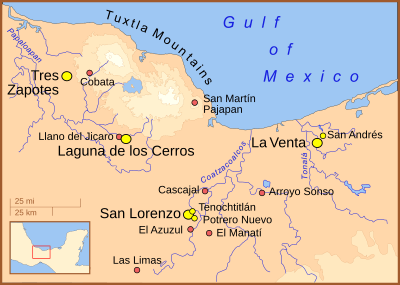The Wrestler (sculpture) facts for kids
The Wrestler is an ancient stone statue made by the Olmec people. It was carved from a type of rock called basalt a very long time ago, between about 1500 BCE and 400 BCE. Many people think it's one of the most important sculptures from the Olmec culture.
This statue is almost life-size and is famous for looking very real. It also seems to show a lot of energy. Since 1964, you can see The Wrestler at the Museo Nacional de Antropología in Mexico City.
The statue is about 66-centimetre (26 in) tall. A farmer found it in 1933 in a place called Arroyo Sonso, in the Mexican state of Veracruz. This area is near the Rio Uxpanapa. The statue is also known as Antonio Plaza Monument 1 or El Luchador Olmeca (which means "the Olmec wrestler" in Spanish). Even though it's called "The Wrestler," experts don't think it actually shows a real wrestler.
Contents
What Does The Wrestler Look Like?
The statue shows a man sitting down. His legs are thin. The right leg is bent in front of him, and the left leg is folded back, almost under his body. His arms are raised up and bent, and his hands are closed tightly.
What's special about this statue is how the man's body is twisted. His shoulders are turned a bit to the right, not directly over his hips. This makes the statue look like it's moving! You can also see his muscles clearly, which adds to the feeling of movement.
The Head and Face
The man in the statue is bald. His head does not have the special flattened shape that you see in many other Olmec statues. He has a mustache and a small beard (a goatee). These features are quite rare in Olmec art. You only see them in a few other carvings, like La Venta Monument 3.
Clothing and Details
The figure wears only a simple loincloth. This makes experts think that the statue might have originally worn more clothes for special ceremonies. These clothes would have been made of materials that have disappeared over time.
You can look at this statue from all sides. The back of the statue is also carefully carved. You can see his shoulder blades and a small bulge above his belt. This shows how much detail the Olmec artists put into their work. Many other Olmec statues are more blocky, but The Wrestler looks much more free and natural.
Who is The Wrestler?

Even though it's called "The Wrestler," experts don't believe the statue shows an actual wrestler. Some think the mustache and goatee might mean the person was important in their society or religion. One art expert, Roy Craven, thought it might be a shaman (a spiritual leader). However, this idea hasn't been widely accepted.
Because the statue looks so unique and detailed, many experts believe it is a portrait. This means it was carved to look like a specific person.
How Old is The Wrestler?
It's hard to know the exact age of the statue because it was found by a farmer, not by archaeologists in a planned dig. Some researchers think it's very old, from around 1200 BCE. Others believe it's from closer to 400 BCE, which is near the end of the Olmec culture. This is because it looks different from older Olmec statues. Most experts, like Michael Coe, simply say it was made between 1500 BCE and 400 BCE.
Is The Wrestler Real?
For a while, some people wondered if The Wrestler was a real Olmec statue. This is because it's different from many other known Olmec artworks in a few ways:
- It doesn't have clear symbols or pictures like other Olmec statues.
- Most sitting Olmec figures have a wide base, but this one has a narrow base.
- The way the upper body is twisted is very unusual for Olmec statues.
- The stone it's made from is also different from other Olmec monuments found nearby.
However, many experts, like Michael Coe and Mary Miller, believe it is real. They point out that we don't know everything about Olmec art. They also say that the statue was found in 1933, long before archaeologists fully understood the Olmec culture. This makes it unlikely that someone could have faked it. They think The Wrestler just shows a part of Olmec art that we don't know much about yet.
Why is The Wrestler Important?
Many archaeologists and art historians have praised The Wrestler.
- Richard Diehl called it the "most spectacular" Olmec three-dimensional sculpture.
- Hugh Honour said it was "the finest of all Olmec sculptures."
- Ignacio Bernal and Michael Coe both called it "one of the greatest" or "supreme examples" of Olmec art. They admired how it showed individual character and human body knowledge.
Mary Ellen Miller, an archaeologist, said The Wrestler is "among the most powerful three-dimensional portraits of the ancient New World."
Another art historian, George Kubler, thought it was one of the greatest sculptures of all time. He admired its moving body, clear muscles, and strong expression. In 1996, the government of Mexico even put an image of The Wrestler on a special silver coin!


